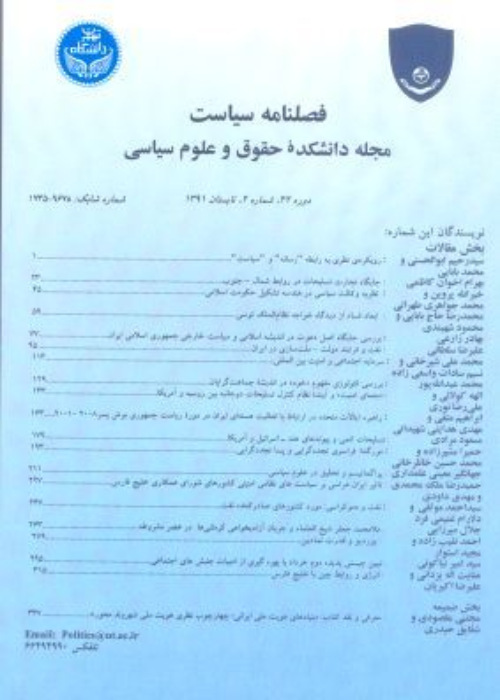Modeling of Oil Deterrence in the Persian Gulf
Author(s):
Article Type:
Research/Original Article (دارای رتبه معتبر)
Abstract:
The role of oil, which seems a constant factor in the contemporary Iranian political studies, has been studied in economic, social, and political domains of the country in various ways. However, oil as a strategic natural resource has also influenced regional and national security, particularly in the Persian Gulf countries which are top exporters in the international oil markets. The interdependency of oil exporters and importers has created some kind of mutual vulnerability, and thus the oil trade requires security. Moreover, the countries in the oil-rich Persian Gulf and its vicinity have been experiencing conflicts and wars for decades. The occurrence of wars has often undermined the security of the global oil trade. We try to explain oil market oscillations, considering that the oil market is volatile, and also the supply, demand, and prices of this strategic resource fluctuate. The share of oil-rich regions and countries in the global oil trade also tend to change continually. Because natural resources such as oil are limited, any increase or decrease in oil production and exports in one region affects other oil-rich regions. Since these fluctuations have consequences, it is assumed that these fluctuations affect the occurrence of violence and war in the oil-rich regions. The main research question is: How do the increase or decrease in the share of Persian Gulf oil exports of the world oil exports affect the occurrence of violence and war in this region and its vicinity? To find an appropriate answer to this question, we articulated and tested the "oil deterrence" hypothesis by using mathematical modeling and analyzing the available data.Deterrence theories in international politics are based on military capability as well as other capabilities which can be transformed into military capability. Nevertheless, oil deterrence is based on the strategic attribute of this commodity and its trade. The high level of mutual vulnerability of the exporting and importing countries makes oil a strategic commodity that requires some stability. Given the inherent oscillation of the oil market, one needs to adopt an efficient method to define and calculate its consequences. We recommend the use of dynamical system theory by which both the oscillations over time and the desirable and undesirable consequences can be defined and calculated. The expectation from modeling is to identify the events resulting from the oil exports' extremes and to show the appropriate range of deterrence of the Persian Gulf oil exports. Oil deterrence requires conditions that are defined as mathematical propositions.When we have numerical information about an object and the results of that information are qualitative, one way to increase the accuracy of the relationship between quantities and qualities is to construct a model of the object. The quantitative (numeric) data on the volume of Persian Gulf oil exports and the world's total oil exports in different time periods are available, and fluctuate. However, information on the occurrence of conflicts and wars are not readily obtainable in numerical form. So, we define a positive quantity as a coefficient of deterrence that is a function of time. Furthermore, we consider the quantity of deterrence, which is also a function of time. These time functions are then placed as a state variable and an output variable in a differential equation. The upper and lower bounds indicate the extremes of the share of the region's oil exports. Interestingly, no war has been waged as long as output quantity oscillates within the upper and lower bands. Therefore, it is expected that the same relationship would be observed in the future. This model has been tested once by simulating the desired information, and a second time by using the actual data collected.The proposed model shows the deterrence category well and has acceptable compatibility with the data. We have computed the oil deterrence bandwidth in the Persian Gulf. This model shows that deterrence against violence and war can be an oscillating phenomenon and be affected by macroeconomic variables. Another result is that the outbreak of wars in the Persian Gulf region is the result of bifurcation resulting from crossing the deterrence band. The results of the calculations show why — despite the high tensions in recent years — a war between Iran and the United States has not started, while the United States invaded Iraq under seemingly similar circumstances. Although the region has been the location of various wars for decades, no war has started in the deterrence band. Therefore, the model can help decision-makers in the region to make forward-looking policy decisions to avoid the escalations of crises to devastating wars. This is a step towards calculating quality matters, which can then include other qualities and clarify the decision-making conditions.
Keywords:
Language:
Persian
Published:
Political Quartely, Volume:52 Issue: 3, 2022
Pages:
691 to 715
https://magiran.com/p2576480
دانلود و مطالعه متن این مقاله با یکی از روشهای زیر امکان پذیر است:
اشتراک شخصی
با عضویت و پرداخت آنلاین حق اشتراک یکساله به مبلغ 1,390,000ريال میتوانید 70 عنوان مطلب دانلود کنید!
اشتراک سازمانی
به کتابخانه دانشگاه یا محل کار خود پیشنهاد کنید تا اشتراک سازمانی این پایگاه را برای دسترسی نامحدود همه کاربران به متن مطالب تهیه نمایند!
توجه!
- حق عضویت دریافتی صرف حمایت از نشریات عضو و نگهداری، تکمیل و توسعه مگیران میشود.
- پرداخت حق اشتراک و دانلود مقالات اجازه بازنشر آن در سایر رسانههای چاپی و دیجیتال را به کاربر نمیدهد.
In order to view content subscription is required
Personal subscription
Subscribe magiran.com for 70 € euros via PayPal and download 70 articles during a year.
Organization subscription
Please contact us to subscribe your university or library for unlimited access!



